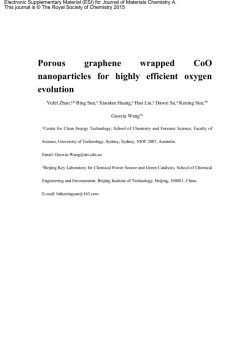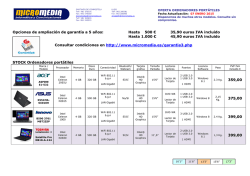
Improved catalytic activity in methanol electro
Electronic Supplementary Material (ESI) for Journal of Materials Chemistry A. This journal is © The Royal Society of Chemistry 2015 Improved catalytic activity in methanol electro-oxidation over nickel form of aluminum-rich Beta-SDS zeolite modified electrode Yanmei Liaoa, Shuxiang Panb, Chaoqun Bianb, Xiangju Mengb, and Feng-Shou Xiaob* a State Key Laboratory of Inorganic Synthesis and Preparative Chemistry, Jilin University, Changchun, 130012, China b Key Lab of Applied Chemistry of Zhejiang Province and Department of Chemistry (Xixi Campus), Zhejiang University, Hangzhou, 310028, China E-mail: [email protected] Experimental Characterization. X-ray diffraction (XRD) patterns were measured with a Rigaku Ultimate IV diffractometer using Cu Kα radiation. Scanning electron microscopy (SEM) images of the samples were performed on a Hitachi SU 1510 apparatus. Nitrogen sorption isotherms at -196 ºC were obtained with a Micromeritics ASAP 2020M system. The Si/Al ratios of the samples and loading of Ni2+ were measured by inductively coupled plasma (ICP) with a Perkin-Elmer optima 8000 emission spectrometer. Electrochemical Measurements: The electrochemical tests were performed using the electrochemical workstation CHI660D (Shanghai Chenhua Instrument Co., Ltd., China). A three compartment electrochemical cell was employed using Hg/HgO as the reference electrode, a platinum foil as the auxiliary electrode, and zeolite modified glass carbon electrode as the working electrode. Table S1. Beta-SDS zeolites with various loadings of Ni2+ species in the assynthesized samples Sample Si/Al Ni2+ (wt.%) Ni-Beta-SDS-0.9 4.5 0.9 Ni-Beta-SDS-2.1 4.9 2.1 Ni-Beta-SDS-4.2 5.0 4.2 Ni-Beta-SDS-5.1 5.0 5.1 Ni-Beta-SDS-6.6 5.0 6.6 Ni-Beta-SDS-7.0 5.0 7.0 a b c Figure S1. (a) XRD pattern, (b) SEM image and (c) nitrogen sorption isotherms of Beta-SDS sample. a b c Figure S2. (a) XRD pattern, (b) SEM image and (c) nitrogen sorption isotherms of Beta-TEA sample. a b c Figure S3. (a) XRD pattern, (b) SEM image and (c) nitrogen sorption isotherms of Ni-Beta-TEA sample. Figure S4. Cyclic voltammograms of Beta-TEA zeolite modified electrode in 0.1 M NaOH and in a mixture of 0.1 M NaOH with 0.1 M CH3OH at scan rate of 50 mV/s. Figure S5. Cyclic voltammograms of Beta-SDS zeolite modified electrode in 0.1 M NaOH and in a mixture of 0.1 M NaOH and 0.1 M CH3OH at scan rate of 50 mV/s. Figure S6. Cyclic voltammograms of glass carbon electrode (GC, black line) and Beta-TEA zeolite modified electrode (red line) in 0.1 M NaOH at scan rate of 50 mV/s. Figure S7. Cyclic voltammograms of glass carbon electrode (GC, black line) and Beta-TEA zeolite modified electrode (red line) in a mixture of 0.1 M NaOH and 0.1 M CH3OH at scan rate of 50 mV/s. Figure S8. Cyclic voltammograms of Ni-Beta-SDS/GC electrocatalysts with various loadings of Ni2+ species in 0.1 M NaOH at scan rate of 50 mV/s. Figure S9. Cyclic voltammograms of Ni-Beta-SDS/GC electrocatalysts with various loadings of Ni2+ species in a mixture of 0.1 M NaOH and 0.1 M CH3OH at scan rate of 50 mV/s. Figure S10. Dependence of current density in the oxidation peak on loading of Ni2+ species in the Ni-Beta-SDS/GC electrocatalysts in 0.1 M NaOH solution. Figure S11. Chronoamperograms in methanol oxidation over Ni-Beta-SDS/GC electrocatalysts with various loadings of Ni2+ species in a mixture of 0.1 M NaOH and 0.1 M CH3OH solutions at a potential step value of 0.7 V for 600 s. Figure S12. The stable current density in methanol oxidation over Ni-Beta-SDS/GC electrocatalysts with various loadings of Ni2+ species in a mixture of 0.1 M NaOH and 0.1 M CH3OH solutions at a potential step value of 0.7 V for 600 s. Figure S13. Chroanoamperogram in methanol oxidation over Pt/C electrode at 0.7 V in a mixture of 0.1 M NaOH and 0.1 M CH3OH solution. Figure S14. Cyclic voltammograms of Ni-Meso-Beta/GC (red line) and Ni-Beta-TEA (black line) electrocatalysts in the mixture of 0.1 M CH3OH and 0.1 M NaOH at scan rate of 50 mV/s.
© Copyright 2025

